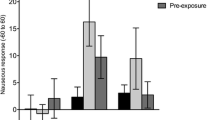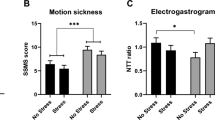Abstract
We examine whether overshadowing by salient stimuli is effective in reducing the ability of a certain environment (the putative conditioned stimulus) to evoke conditioned nausea in healthy humans that experience nausea-evoking rotation (as the unconditioned stimulus, US) in that environment. Twenty-four rotation-susceptible subjects (12 males, 12 females) were randomly assigned to receive either overshadowing by salient tasting beverages (OS+), or a control treatment (a familiar beverage, water; OS−) prior to rotation on three consecutive days (acquisition). To control for taste experiences, the alternative beverage was consumed 12 h later in the home environment (OS+: water, OS−: salient beverage). At Day 4 (test), all subjects drank the familiar beverage (water) prior to rotation (US). Rotation was standardized as 2 × 1-min rotation/day. Nausea was determined by a 7-item symptom scale measuring symptom number (SN) prior to (anticipatory), immediately after, and 15 and 30 min after rotation and by the Nausea Profile (NP) questionnaire immediately after rotation. Cortisol and tumour necrosis factor (TNF)-α in saliva were sampled at the same time-points. SN and cortisol were also measured at home. Overshadowing reduced anticipatory (conditioned) SN. Post-rotation nausea (i.e. the unconditioned response) measured by the NP decreased within the OS+ group only. Anticipatory cortisol and TNF-α were not affected by overshadowing. Treatment × gender interactions manifested for post-rotation cortisol and TNF-α. Groups did not differ in SN and cortisol at home. Overshadowing is effective in reducing symptoms of anticipatory nausea and rotation-induced unconditioned nausea; its effect on endocrine and immunological parameters is gender specific. Its application in alleviation of anticipatory nausea in cancer patients is considered.





Similar content being viewed by others
References
Aapro MS, Kirchner V, Terrey JP (1994) The incidence of anticipatory nausea and vomiting after repeat cycle chemotherapy: the effect of granisetron. Br J Cancer 69:957–960
Aapro MS, Molassiotis A, Olver I (2005) Anticipatory nausea and vomiting. Support Care Cancer 13:117–121
Alba E, Bastus R, de Andres L, Sola C, Paredes A, Lopez Lopez JJ (1989) Anticipatory nausea and vomiting: prevalence and predictors in chemotherapy patients. Oncology 46:26–30
Andrykowski MA, Jacobsen PB, Marks E, Gorfinkle K, Hakes TB, Kaufman RJ, Currie VE, Holland JC, Redd WH (1988) Prevalence, predictors, and course of anticipatory nausea in women receiving adjuvant chemotherapy for breast cancer. Cancer 62:2607–2613
Boakes RA, Tarrier N, Barnes BW, Tattersall MH (1993) Prevalence of anticipatory nausea and other side-effects in cancer patients receiving chemotherapy. Eur J Cancer 29A:866–870
Broberg DJ, Bernstein IL (1987) Candy as a scapegoat in the prevention of food aversions in children receiving chemotherapy. Cancer 60:2344–2347
Cannon DS, Best MR, Batson JD, Brown ER, Rubenstein JA, Carrell LE (1985) Interfering with taste aversion learning in rats: the role of associative interference. Appetite 6:1–19
Chambers KC (1976) Hormonal influences on sexual dimorphism in rate of extinction of a conditioned taste aversion in rats. J Comp Physiol Psychol 90:851–856
Cohen J (1977) Statistical power analysis for the behavioral sciences. Academic Press, New York
Cohen J (1992) A power primer. Psychol Bull 112:155–159
Dalla C, Shors TJ (2009) Sex differences in learning processes of classical and instrumental conditioning. Physiol Behav 97:229–238. doi:10.1016/j.physbeh.2009.02.035
Dantzer R (2001) Cytokine-induced sickness behavior: mechanisms and implications. Ann N Y Acad Sci 933:222–234. doi:10.1111/j.1749-6632.2001.tb05827.x
Dressendörfer RA, Kirschbaum C, Rohde W, Stahl F, Strasburger CJ (1992) Synthesis of a cortisol-biotin conjugate and evaluation as a tracer in an immunoassay for salivary cortisol measurement. J Steroid Biochem Mol Biol 43:683–692
Durlach PJ, Rescorla RA (1980) Potentiation rather than overshadowing in flavor-aversion learning: an analysis in terms of within-compound associations. J Exp Psychol Anim Behav Process 6:175–187
Faul F, Erdfelder E, Lang A-G, Buchner A (2007) G*Power 3: a flexible statistical power analysis program for the social, behavioral, and biomedical sciences. Behav Res Methods 39:175–191
Haiderali A, Menditto L, Good M, Teitelbaum A, Wegner J (2011) Impact on daily functioning and indirect/direct costs associated with chemotherapy-induced nausea and vomiting (CINV) in a US population. Support Care Cancer 19:843–851
Jordan K, Kasper C, Schmoll HJ (2005) Chemotherapy-induced nausea and vomiting: current and new standards in the antiemetic prophylaxis and treatment. Eur J Cancer 41:199–205
Kamen C, Tejani MA, Chandwani K, Janelsins M, Peoples AR, Roscoe JA, Morrow GR (2014) Anticipatory nausea and vomiting due to chemotherapy. Eur J Pharmacol 722:172–179
Klosterhalfen S, Rüttgers A, Krumrey E, Otto B, Stockhorst U, Riepl RL, Probst T, Enck P (2000) Pavlovian conditioning of taste aversion using a motion sickness paradigm. Psychosom Med 62:671–677
Klosterhalfen S, Kellermann S, Stockhorst U, Wolf J, Kirschbaum C, Hall G, Enck P (2005) Latent inhibition of rotation-chair induced nausea in healthy male and female volunteers. Psychosom Med 67:335–340
Klosterhalfen S, Kellermann S, Braun S, Kowalski A, Schrauth M, Zipfel S, Enck P (2009) Gender and the nocebo response following conditioning and expectancy. J Psychosom Res 66:323–328
Lekander M, Elofsson S, Neve IM, Hansson LO, Unden AL (2004) Self-rated health is related to levels of circulating cytokines. Psychosom Med 66:559–563
Lubow RE, Moore AU (1959) Latent inhibition: the effect of non-reinforced pre-exposure to the conditional stimulus. J Comp Physiol Psychol 52:415–419
Meissner K, Enck P, Muth ER, Kellermann S, Klosterhalfen S (2009) Cortisol levels predict motion sickness tolerance in women but not in men. Physiol Behav 97:102–106
Miller JS, Jagielo JA, Spear NE (1990) Changes in the retrievability of associations to elements of the compound CS determine the expression of overshadowing. Anim Learn Behav 18:157–161
Morrow GR, Hickok JT, Rosenthal SN (1995) Progress in reducing nausea and emesis—comparisons of ondansetron (Zofran), granisetron (Kytril), and tropisetron (Navoban). Cancer 76:343–357
Muth ER, Stern RM, Thayer JF, Koch KL (1996) Assessment of the multiple dimensions of nausea: the Nausea Profile (NP). J Psychosom Res 40:511–520
Pavlov IP (1927/1960) Conditioned reflexes. Dover Publications Inc, New York
Rogers RC, van Meter MJ, Hermann GE (2006) Tumor necrosis factor potentiates vagal afferent signaling by modulating ryanodine channels. J Neurosci 26:12642–12646. doi:10.1523/jneurosci.3530-06.2006
Rohleder N, Otto B, Wolf J, Klose J, Kirschbaum C, Enck P, Klosterhalfen S (2006) Sex-specific adaptation of endocrine and inflammatory responses to repeated nauseogenic body rotation. Psychoneuroendocrinology 31:226–236
Schmäl F (2013) Neuronal mechanisms and the treatment of motion sickness. Pharmacology 91:229–241
Shors TJ (2004) Learning during stressful times. Learn Mem 11:137–144
Stockhorst U, Klosterhalfen S, Klosterhalfen W, Winkelmann M, Steingrueber HJ (1993) Anticipatory nausea in cancer patients receiving chemotherapy: classical conditioning etiology and therapeutical implications. Integr Physiol Behav Sci 28:177–181
Stockhorst U, Wiener JA, Klosterhalfen S, Klosterhalfen W, Aul C, Steingrüber HJ (1998) Effects of overshadowing on conditioned nausea in cancer patients: an experimental study. Physiol Behav 64:743–753
Stockhorst U, Spennes-Saleh S, Körholz D, Göbel U, Schneider ME, Steingrüber HJ, Klosterhalfen S (2000) Anticipatory symptoms and anticipatory immune responses in pediatric cancer patients receiving chemotherapy: features of a classically conditioned response. Brain Behav Immun 14:198–218
Symonds M, Hall G (1999) Overshadowing not potentiation of illness-based contextual conditioning by a novel taste. Anim Learn Behav 27:379–390
Symonds M, Hall G (2002) Postinjection suppression of drinking is modified by the presence of conditioned contextual cues: implications for both anticipatory and posttreatment nausea in humans. Anim Learn Behav 30:355–362
Watanobe H (2002) Sexual dimorphism in the pituitary-adrenal response to tumor necrosis factor-α but not to interleukin-6, in the rat. Brain Res Bull 57:151–155
Yates BJ, Miller AD, Lucot JB (1998) Physiological basis and pharmacology of motion sickness: an update. Br Res Bull 47:395–406
Zeidan MA, Igoe SA, Linnman C, Vitala A, Levine JB, Klibanski A, Goldstein JM, Milad M (2011) Estradiol modulates medial prefrontal cortex and amygdala activity during fear extinction in women and female rats. Biol Psychiatry 70:920–927. doi:10.1016/j.biopsych.05.016
Acknowledgments
The study was supported by the Wellcome Trust by a grant to US, GH and SK. We gratefully acknowledge the contribution of Dipl.-Psych. Sandra Kellermann who did the subject recruitment, conducted the screening, and the main experimental study.
Conflict of interest
The authors declare that they have no conflict of interest.
Author information
Authors and Affiliations
Corresponding author
Rights and permissions
About this article
Cite this article
Stockhorst, U., Hall, G., Enck, P. et al. Effects of overshadowing on conditioned and unconditioned nausea in a rotation paradigm with humans. Exp Brain Res 232, 2651–2664 (2014). https://doi.org/10.1007/s00221-014-3998-6
Received:
Accepted:
Published:
Issue Date:
DOI: https://doi.org/10.1007/s00221-014-3998-6




